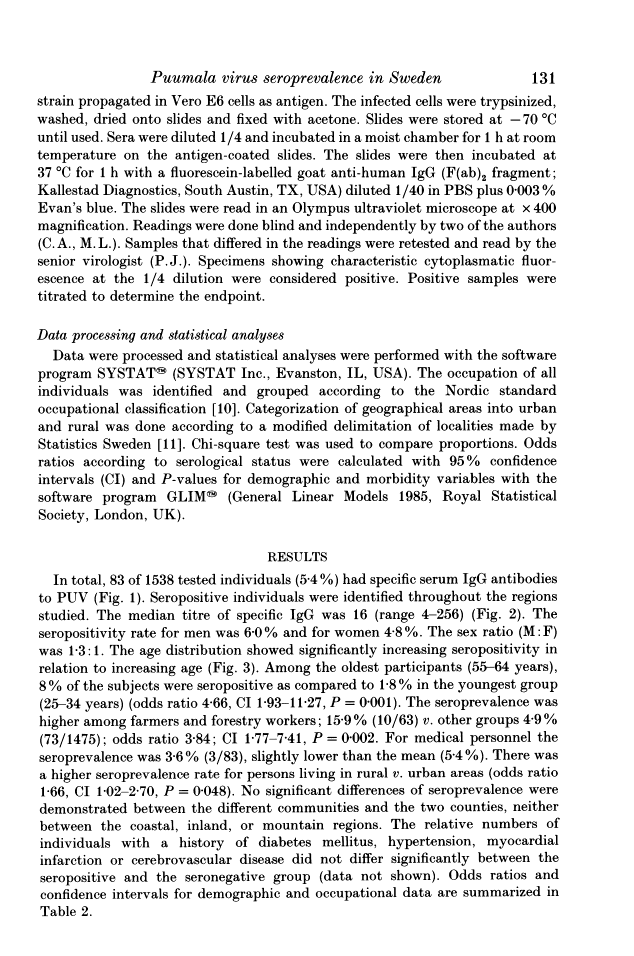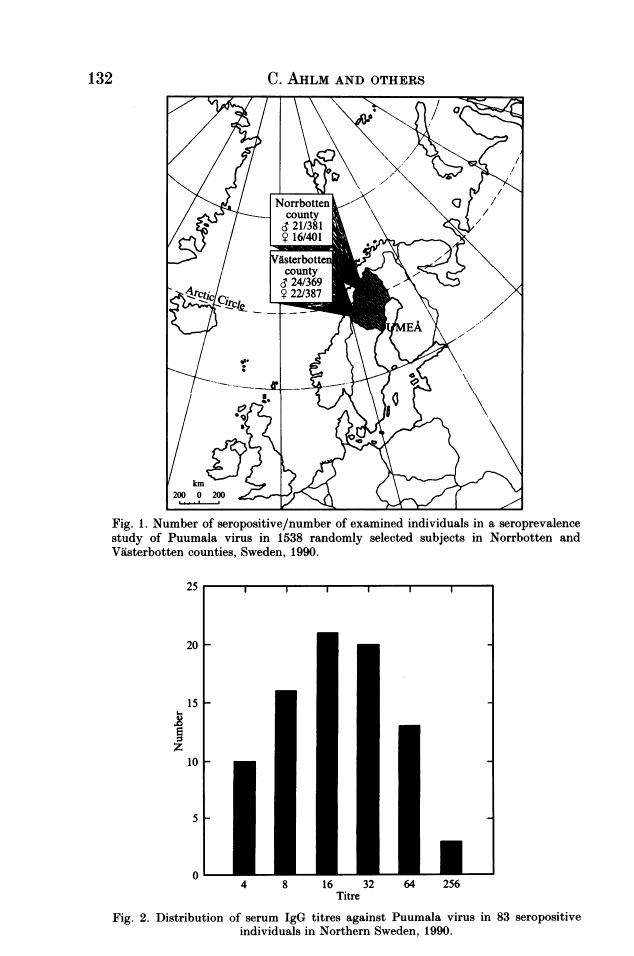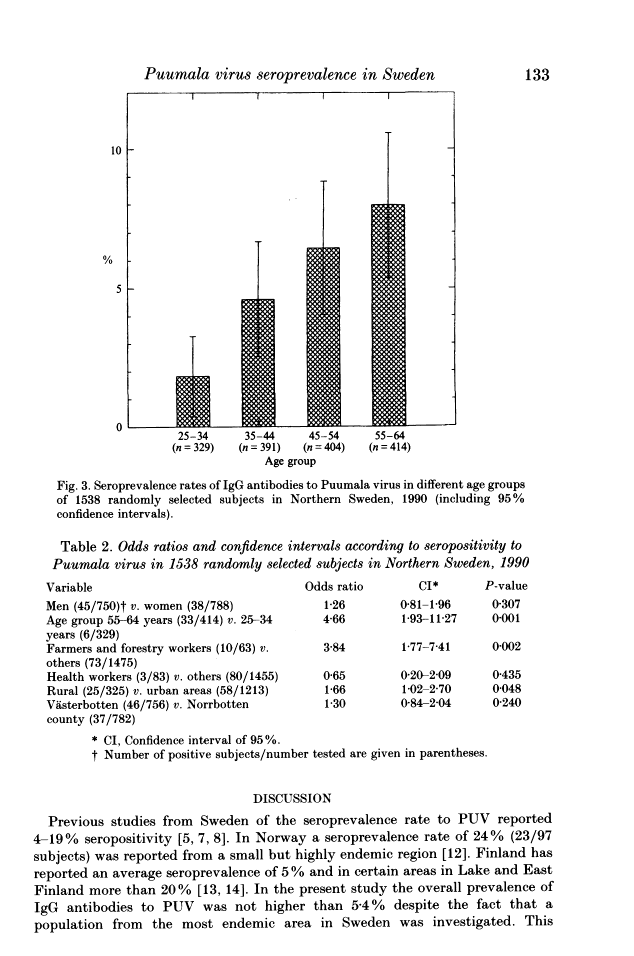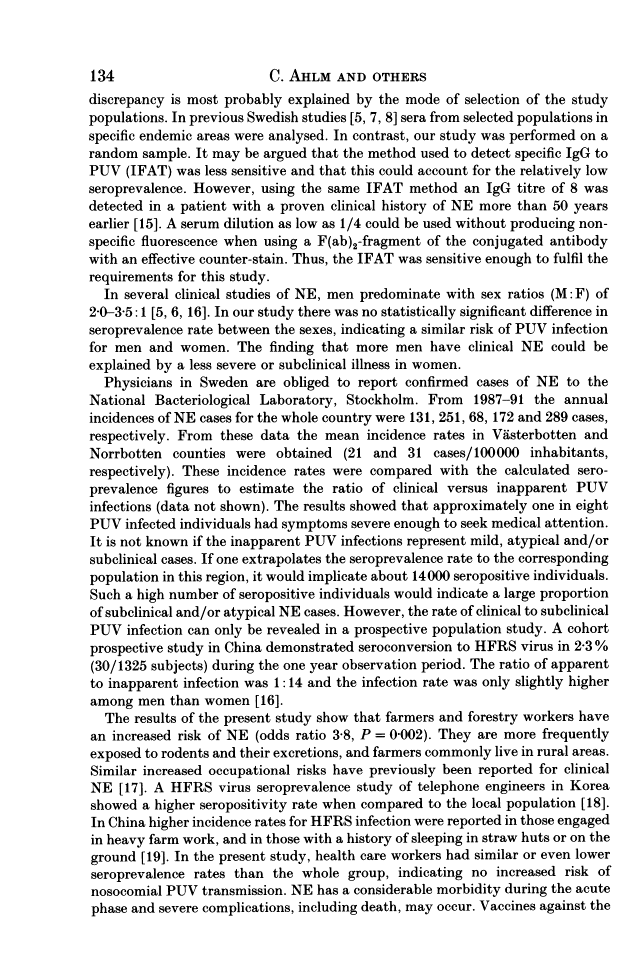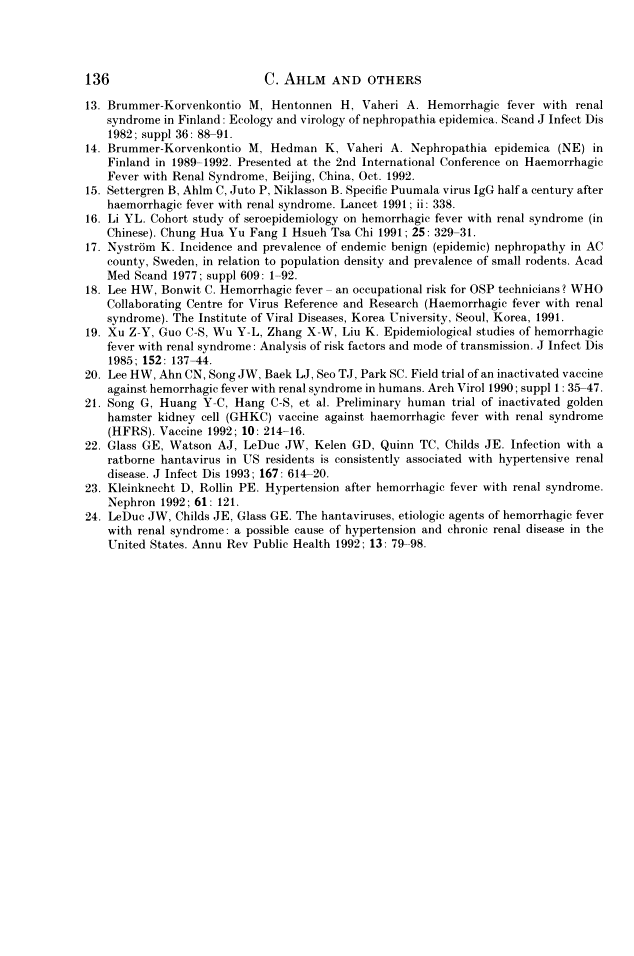Abstract
Free full text

Prevalence of serum IgG antibodies to Puumala virus (haemorrhagic fever with renal syndrome) in northern Sweden.
Abstract
A stratified and randomly-selected population sample was identified in 1990 in order to study the seroprevalence of nephropathia epidemica (haemorrhagic fever with renal syndrome) in Northern Sweden. Sera from 1538 subjects (750 men, 788 women), 25-64 years of age, were analysed for the presence of Puumala virus (PUV) specific-IgG by the indirect immunofluorescence antibody test. Specific IgG was detected in sera from 83 subjects (5.4%). Men and women had similar seroprevalence rates. The highest seroprevalences were found in subjects 55 years or older (8.0%) and among farmers and forestry workers (15.9%). The geographic distribution of seropositive individuals was uneven and there were significantly more seropositive persons in rural than in urban areas (P < 0.05).
Full text
Full text is available as a scanned copy of the original print version. Get a printable copy (PDF file) of the complete article (867K), or click on a page image below to browse page by page. Links to PubMed are also available for Selected References.
Selected References
These references are in PubMed. This may not be the complete list of references from this article.
- GAJDUSEK DC. Virus hemorrhagic fevers. Special reference to hemorrhagic fever with renal syndrome (epidemic hemorrhagic fever). J Pediatr. 1962 Jun;60:841–857. [Abstract] [Google Scholar]
- Settergren B. Nephropathia epidemica (hemorrhagic fever with renal syndrome) in Scandinavia. Rev Infect Dis. 1991 Jul-Aug;13(4):736–744. [Abstract] [Google Scholar]
- Niklasson B, Le Duc J. Isolation of the nephropathia epidemica agent in Sweden. Lancet. 1984 May 5;1(8384):1012–1013. [Abstract] [Google Scholar]
- Niklasson B, LeDuc JW. Epidemiology of nephropathia epidemica in Sweden. J Infect Dis. 1987 Feb;155(2):269–276. [Abstract] [Google Scholar]
- Settergren B, Juto P, Wadell G, Trollfors B, Norrby SR. Incidence and geographic distribution of serologically verified cases of nephropathia epidemica in Sweden. Am J Epidemiol. 1988 Apr;127(4):801–807. [Abstract] [Google Scholar]
- Niklasson B, Nyman L, Linde A, Grandien M, Dalrymple J. An epidemiological survey of nephropathia epidemica in Sweden. Scand J Infect Dis. 1983;15(3):239–245. [Abstract] [Google Scholar]
- Niklasson B, Leduc J, Nyström K, Nyman L. Nephropathia epidemica: incidence of clinical cases and antibody prevalence in an endemic area of Sweden. Epidemiol Infect. 1987 Oct;99(2):559–562. [Europe PMC free article] [Abstract] [Google Scholar]
- The World Health Organization MONICA Project (monitoring trends and determinants in cardiovascular disease): a major international collaboration. WHO MONICA Project Principal Investigators. J Clin Epidemiol. 1988;41(2):105–114. [Abstract] [Google Scholar]
- Sommer AI, Traavik T, Mehl R, Berdal BP, Dalrymple J. Hemorrhagic fever with renal syndrome (nephropathia epidemica) in Norway: seroepidemiology 1981-1985. Scand J Infect Dis. 1988;20(3):267–274. [Abstract] [Google Scholar]
- Brummer-Korvenkontio M, Henttonen H, Vaheri A. Hemorrhagic fever with renal syndrome in Finland: ecology and virology of nephropathia epidemica. Scand J Infect Dis Suppl. 1982;36:88–91. [Abstract] [Google Scholar]
- Xu ZY, Guo CS, Wu YL, Zhang XW, Liu K. Epidemiological studies of hemorrhagic fever with renal syndrome: analysis of risk factors and mode of transmission. J Infect Dis. 1985 Jul;152(1):137–144. [Abstract] [Google Scholar]
- Song G, Huang YC, Hang CS, Hao FY, Li DX, Zheng XL, Liu WM, Li SL, Huo ZW, Huei LJ, et al. Preliminary human trial of inactivated golden hamster kidney cell (GHKC) vaccine against haemorrhagic fever with renal syndrome (HFRS). Vaccine. 1992;10(4):214–216. [Abstract] [Google Scholar]
- Glass GE, Watson AJ, LeDuc JW, Kelen GD, Quinn TC, Childs JE. Infection with a ratborne hantavirus in US residents is consistently associated with hypertensive renal disease. J Infect Dis. 1993 Mar;167(3):614–620. [Abstract] [Google Scholar]
- Kleinknecht D, Rollin PE. Hypertension after hemorrhagic fever with renal syndrome. Nephron. 1992;61(1):121–121. [Abstract] [Google Scholar]
- LeDuc JW, Childs JE, Glass GE. The Hantaviruses, etiologic agents of hemorrhagic fever with renal syndrome: a possible cause of hypertension and chronic renal disease in the United States. Annu Rev Public Health. 1992;13:79–98. [Abstract] [Google Scholar]
Associated Data
Articles from Epidemiology and Infection are provided here courtesy of Cambridge University Press
Full text links
Read article at publisher's site: https://doi.org/10.1017/s0950268800051542
Read article for free, from open access legal sources, via Unpaywall:
https://www.cambridge.org/core/services/aop-cambridge-core/content/view/F0941932DEB65FA1AE76BD0EC6C801DC/S0950268800051542a.pdf/div-class-title-prevalence-of-serum-igg-antibodies-to-puumala-virus-haemorrhagic-fever-with-renal-syndrome-in-northern-sweden-div.pdf
Citations & impact
Impact metrics
Citations of article over time
Smart citations by scite.ai
Explore citation contexts and check if this article has been
supported or disputed.
https://scite.ai/reports/10.1017/s0950268800051542
Article citations
Seroprevalence of hantavirus infection in non-epidemic settings over four decades: a systematic review and meta-analysis.
BMC Public Health, 24(1):2553, 19 Sep 2024
Cited by: 0 articles | PMID: 39300359 | PMCID: PMC11414058
Review Free full text in Europe PMC
Nephropathia Epidemica Caused by Puumala Virus in Bank Voles, Scania, Southern Sweden.
Emerg Infect Dis, 30(4):732-737, 01 Apr 2024
Cited by: 0 articles | PMID: 38526134 | PMCID: PMC10977816
Occupational Hantavirus Infections in Agricultural and Forestry Workers: A Systematic Review and Metanalysis.
Viruses, 13(11):2150, 25 Oct 2021
Cited by: 8 articles | PMID: 34834957 | PMCID: PMC8621010
Review Free full text in Europe PMC
Detection and Genetic Characterization of Puumala Orthohantavirus S-Segment in Areas of France Non-Endemic for Nephropathia Epidemica.
Pathogens, 9(9):E721, 01 Sep 2020
Cited by: 3 articles | PMID: 32882953 | PMCID: PMC7559001
Sex Drives Dimorphic Immune Responses to Viral Infections.
J Immunol, 198(5):1782-1790, 01 Mar 2017
Cited by: 128 articles | PMID: 28223406 | PMCID: PMC5325721
Review Free full text in Europe PMC
Go to all (42) article citations
Similar Articles
To arrive at the top five similar articles we use a word-weighted algorithm to compare words from the Title and Abstract of each citation.
Prevalence of antibodies specific to Puumala virus among farmers in Sweden.
Scand J Work Environ Health, 24(2):104-108, 01 Apr 1998
Cited by: 18 articles | PMID: 9630057
Infections in an Alpine environment: antibodies to hantaviruses, leptospira, rickettsiae, and Borrelia burgdorferi in defined Italian populations.
Am J Trop Med Hyg, 48(1):20-25, 01 Jan 1993
Cited by: 21 articles | PMID: 8093990
Human Puumala hantavirus infection in northern Sweden; increased seroprevalence and association to risk and health factors.
BMC Infect Dis, 16(1):566, 13 Oct 2016
Cited by: 18 articles | PMID: 27737653 | PMCID: PMC5064900
Haemorrhagic fever with renal syndrome, virological and epidemiological aspects.
Pediatr Nephrol, 6(2):201-204, 01 Mar 1992
Cited by: 12 articles | PMID: 1349231
Review


